Business Plan for Burger Hut: Marketing Strategies and Financial Projections
VerifiedAdded on 2023/06/03
|20
|3623
|405
AI Summary
This business plan evaluates the marketing strategies and financial projections for Burger Hut, a new start-up business in Australia that offers healthy burgers made with brown bread and oats. The report includes a SWOT analysis, target market, competitor analysis, and marketing mix strategies. The financial projections include start-up costs, sales forecast, and profit and loss statement.
Contribute Materials
Your contribution can guide someone’s learning journey. Share your
documents today.
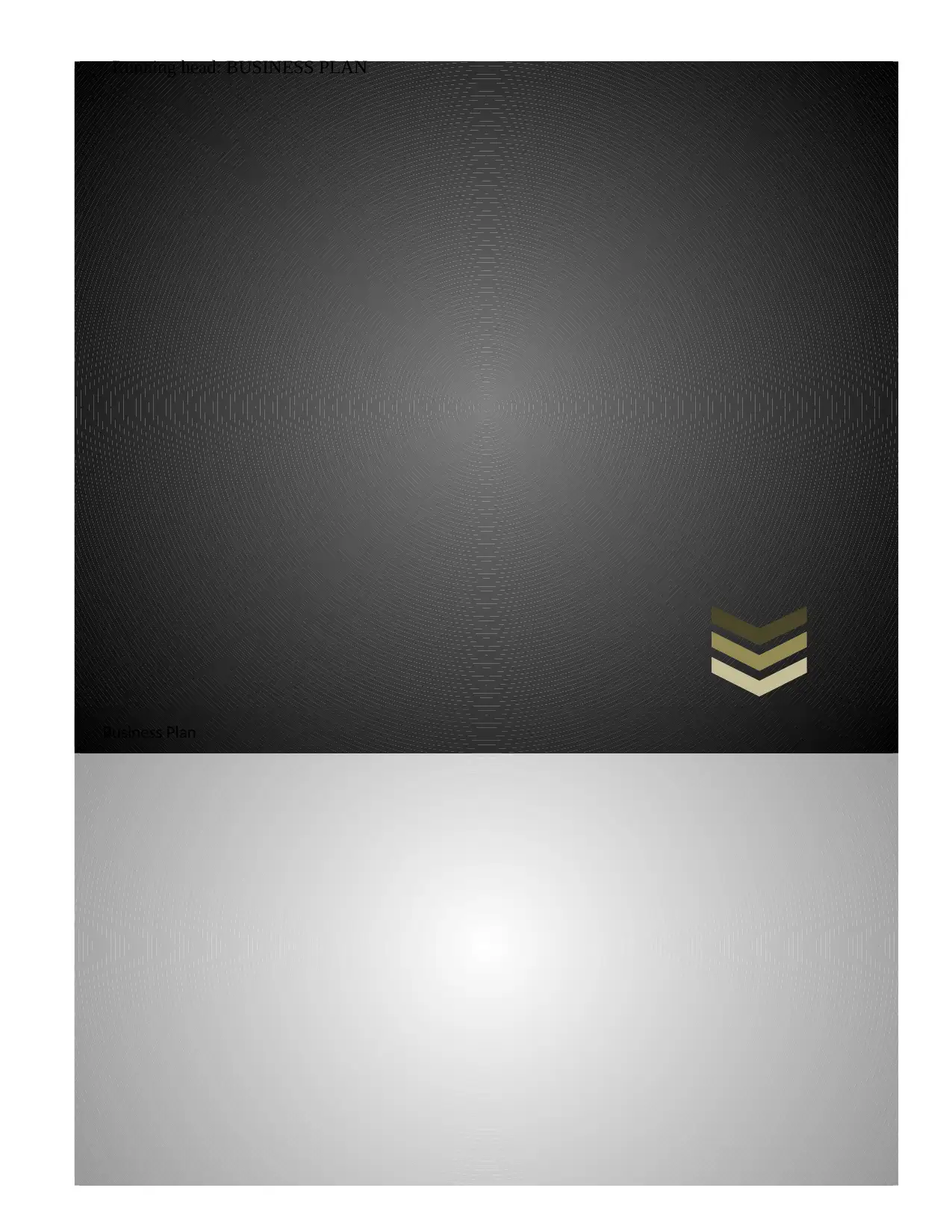
Business Plan
Running head: BUSINESS PLAN
Running head: BUSINESS PLAN
Secure Best Marks with AI Grader
Need help grading? Try our AI Grader for instant feedback on your assignments.
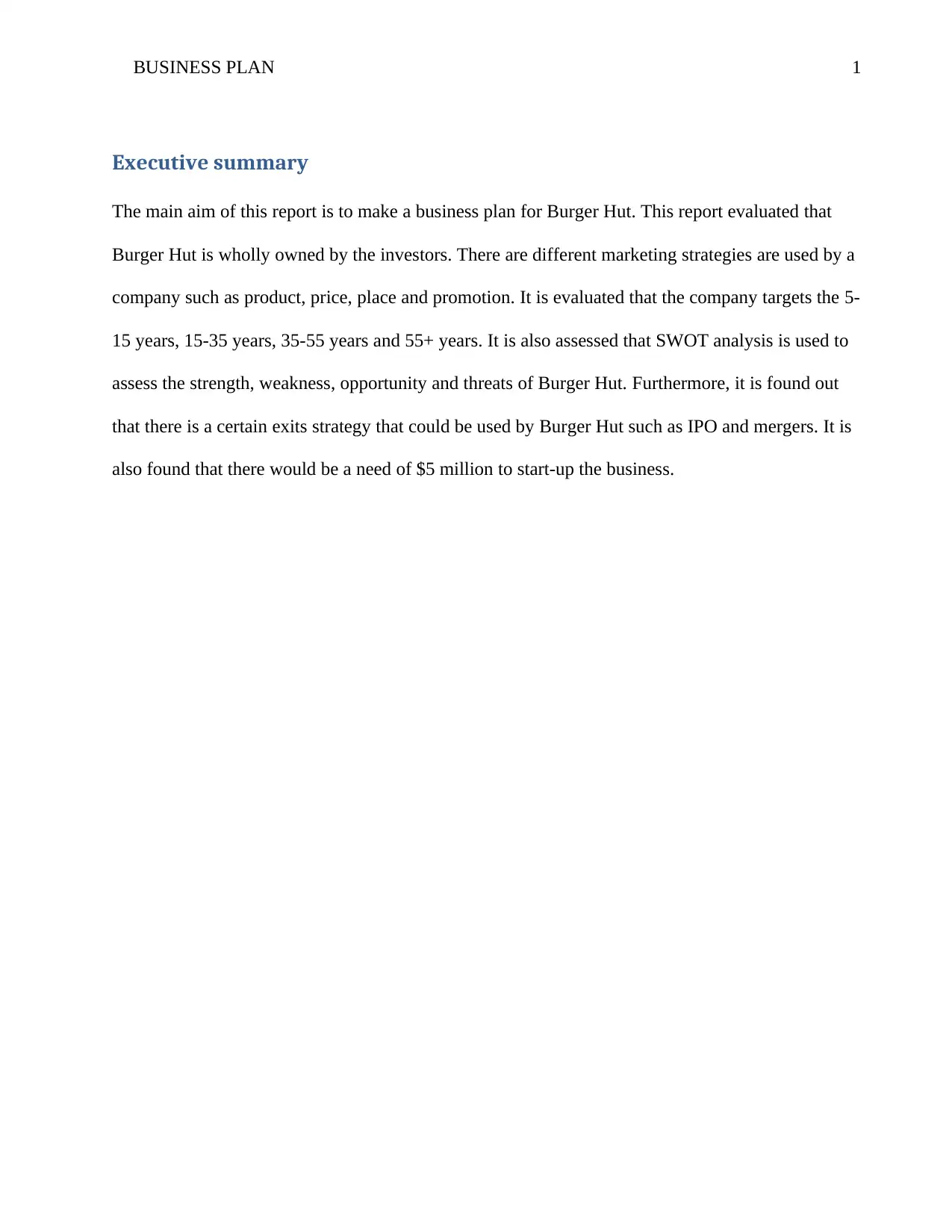
BUSINESS PLAN 1
Executive summary
The main aim of this report is to make a business plan for Burger Hut. This report evaluated that
Burger Hut is wholly owned by the investors. There are different marketing strategies are used by a
company such as product, price, place and promotion. It is evaluated that the company targets the 5-
15 years, 15-35 years, 35-55 years and 55+ years. It is also assessed that SWOT analysis is used to
assess the strength, weakness, opportunity and threats of Burger Hut. Furthermore, it is found out
that there is a certain exits strategy that could be used by Burger Hut such as IPO and mergers. It is
also found that there would be a need of $5 million to start-up the business.
Executive summary
The main aim of this report is to make a business plan for Burger Hut. This report evaluated that
Burger Hut is wholly owned by the investors. There are different marketing strategies are used by a
company such as product, price, place and promotion. It is evaluated that the company targets the 5-
15 years, 15-35 years, 35-55 years and 55+ years. It is also assessed that SWOT analysis is used to
assess the strength, weakness, opportunity and threats of Burger Hut. Furthermore, it is found out
that there is a certain exits strategy that could be used by Burger Hut such as IPO and mergers. It is
also found that there would be a need of $5 million to start-up the business.
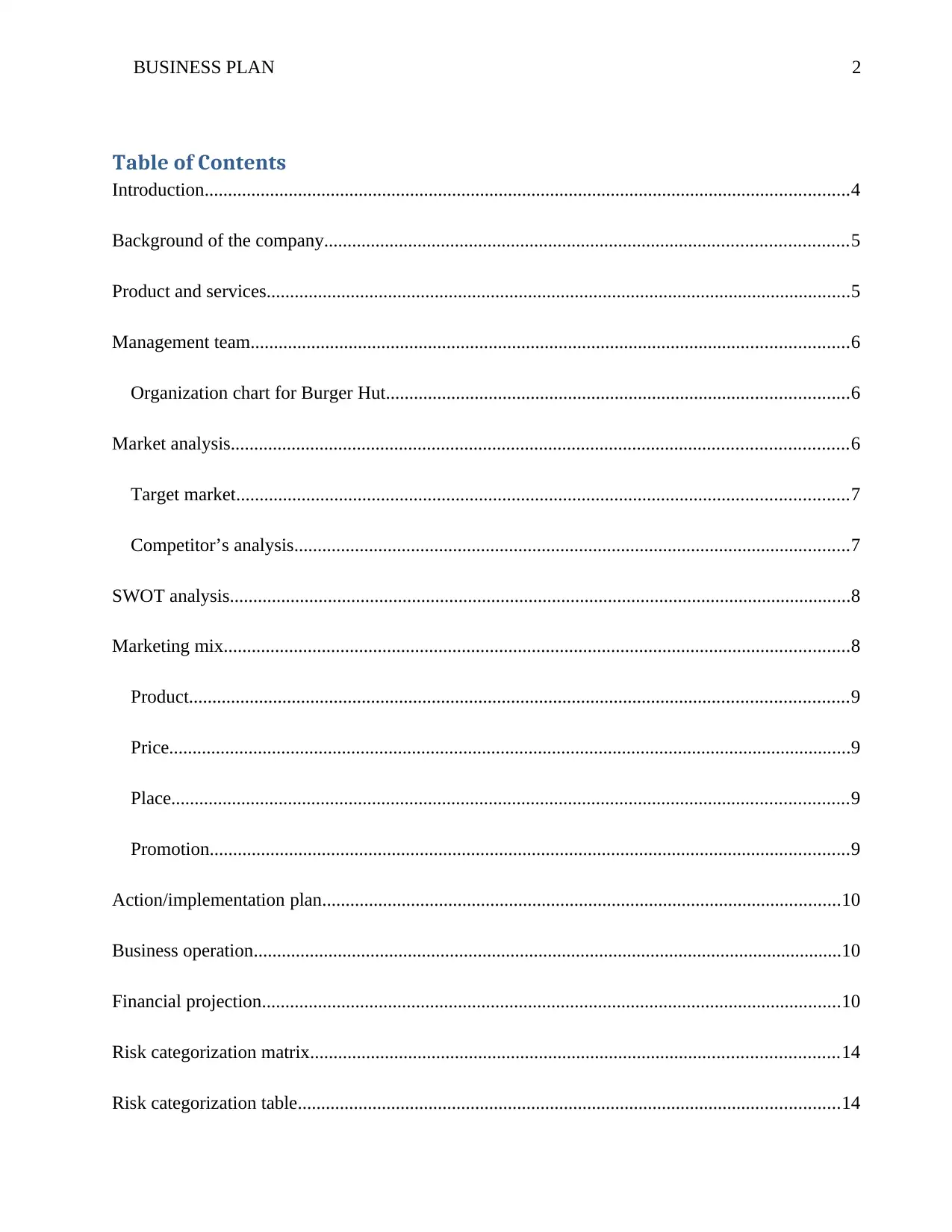
BUSINESS PLAN 2
Table of Contents
Introduction..........................................................................................................................................4
Background of the company................................................................................................................5
Product and services.............................................................................................................................5
Management team................................................................................................................................6
Organization chart for Burger Hut...................................................................................................6
Market analysis....................................................................................................................................6
Target market...................................................................................................................................7
Competitor’s analysis.......................................................................................................................7
SWOT analysis.....................................................................................................................................8
Marketing mix......................................................................................................................................8
Product.............................................................................................................................................9
Price..................................................................................................................................................9
Place.................................................................................................................................................9
Promotion.........................................................................................................................................9
Action/implementation plan...............................................................................................................10
Business operation..............................................................................................................................10
Financial projection............................................................................................................................10
Risk categorization matrix.................................................................................................................14
Risk categorization table....................................................................................................................14
Table of Contents
Introduction..........................................................................................................................................4
Background of the company................................................................................................................5
Product and services.............................................................................................................................5
Management team................................................................................................................................6
Organization chart for Burger Hut...................................................................................................6
Market analysis....................................................................................................................................6
Target market...................................................................................................................................7
Competitor’s analysis.......................................................................................................................7
SWOT analysis.....................................................................................................................................8
Marketing mix......................................................................................................................................8
Product.............................................................................................................................................9
Price..................................................................................................................................................9
Place.................................................................................................................................................9
Promotion.........................................................................................................................................9
Action/implementation plan...............................................................................................................10
Business operation..............................................................................................................................10
Financial projection............................................................................................................................10
Risk categorization matrix.................................................................................................................14
Risk categorization table....................................................................................................................14
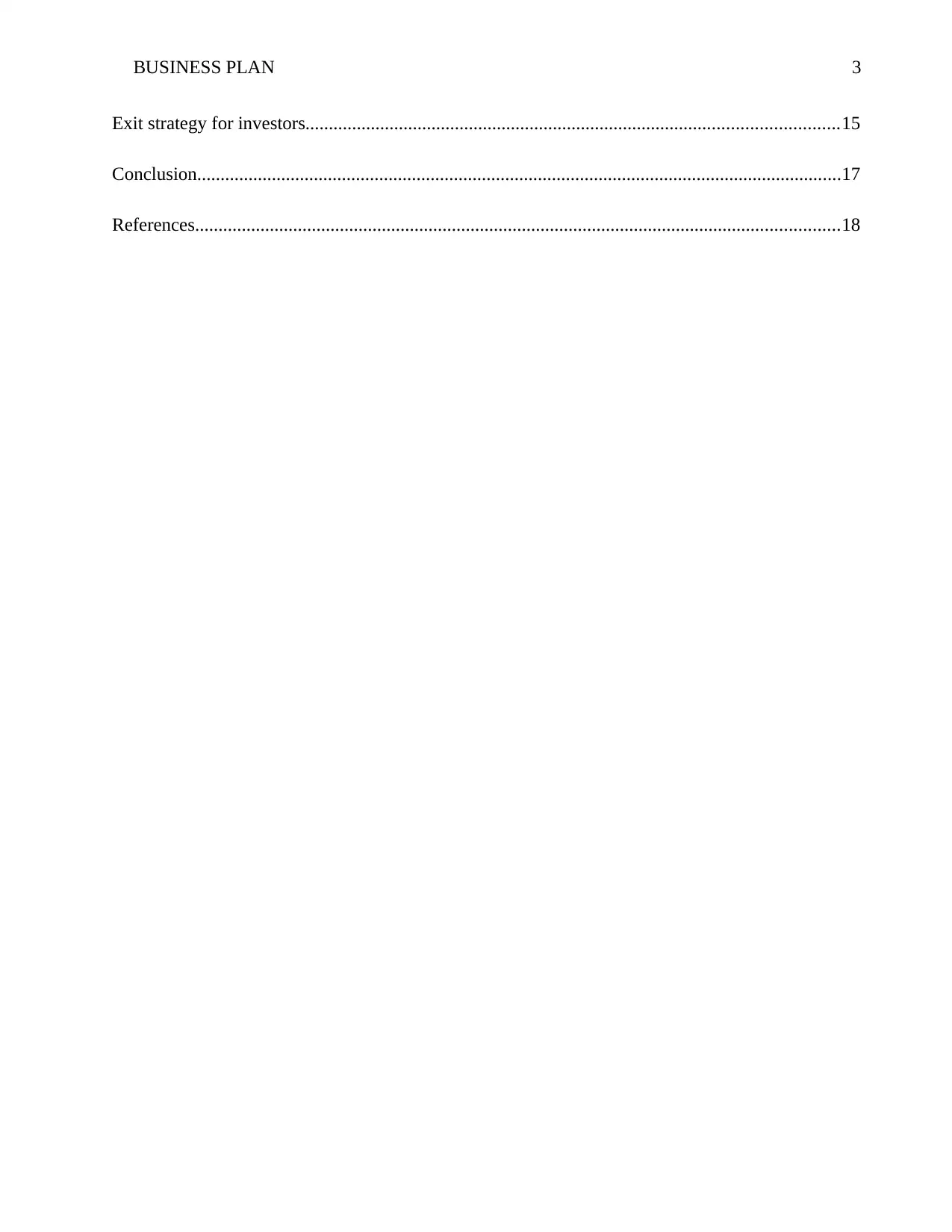
BUSINESS PLAN 3
Exit strategy for investors..................................................................................................................15
Conclusion..........................................................................................................................................17
References..........................................................................................................................................18
Exit strategy for investors..................................................................................................................15
Conclusion..........................................................................................................................................17
References..........................................................................................................................................18
Secure Best Marks with AI Grader
Need help grading? Try our AI Grader for instant feedback on your assignments.
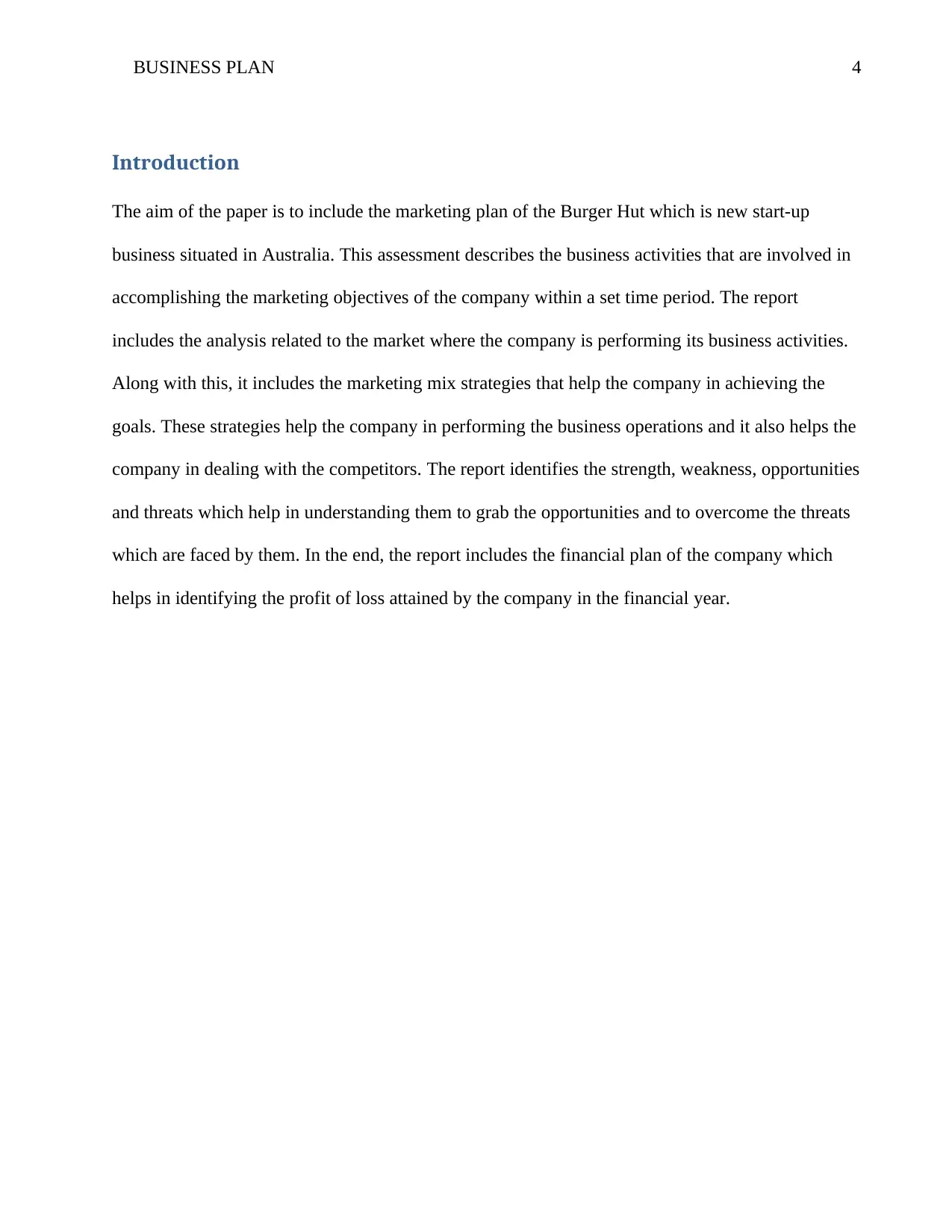
BUSINESS PLAN 4
Introduction
The aim of the paper is to include the marketing plan of the Burger Hut which is new start-up
business situated in Australia. This assessment describes the business activities that are involved in
accomplishing the marketing objectives of the company within a set time period. The report
includes the analysis related to the market where the company is performing its business activities.
Along with this, it includes the marketing mix strategies that help the company in achieving the
goals. These strategies help the company in performing the business operations and it also helps the
company in dealing with the competitors. The report identifies the strength, weakness, opportunities
and threats which help in understanding them to grab the opportunities and to overcome the threats
which are faced by them. In the end, the report includes the financial plan of the company which
helps in identifying the profit of loss attained by the company in the financial year.
Introduction
The aim of the paper is to include the marketing plan of the Burger Hut which is new start-up
business situated in Australia. This assessment describes the business activities that are involved in
accomplishing the marketing objectives of the company within a set time period. The report
includes the analysis related to the market where the company is performing its business activities.
Along with this, it includes the marketing mix strategies that help the company in achieving the
goals. These strategies help the company in performing the business operations and it also helps the
company in dealing with the competitors. The report identifies the strength, weakness, opportunities
and threats which help in understanding them to grab the opportunities and to overcome the threats
which are faced by them. In the end, the report includes the financial plan of the company which
helps in identifying the profit of loss attained by the company in the financial year.
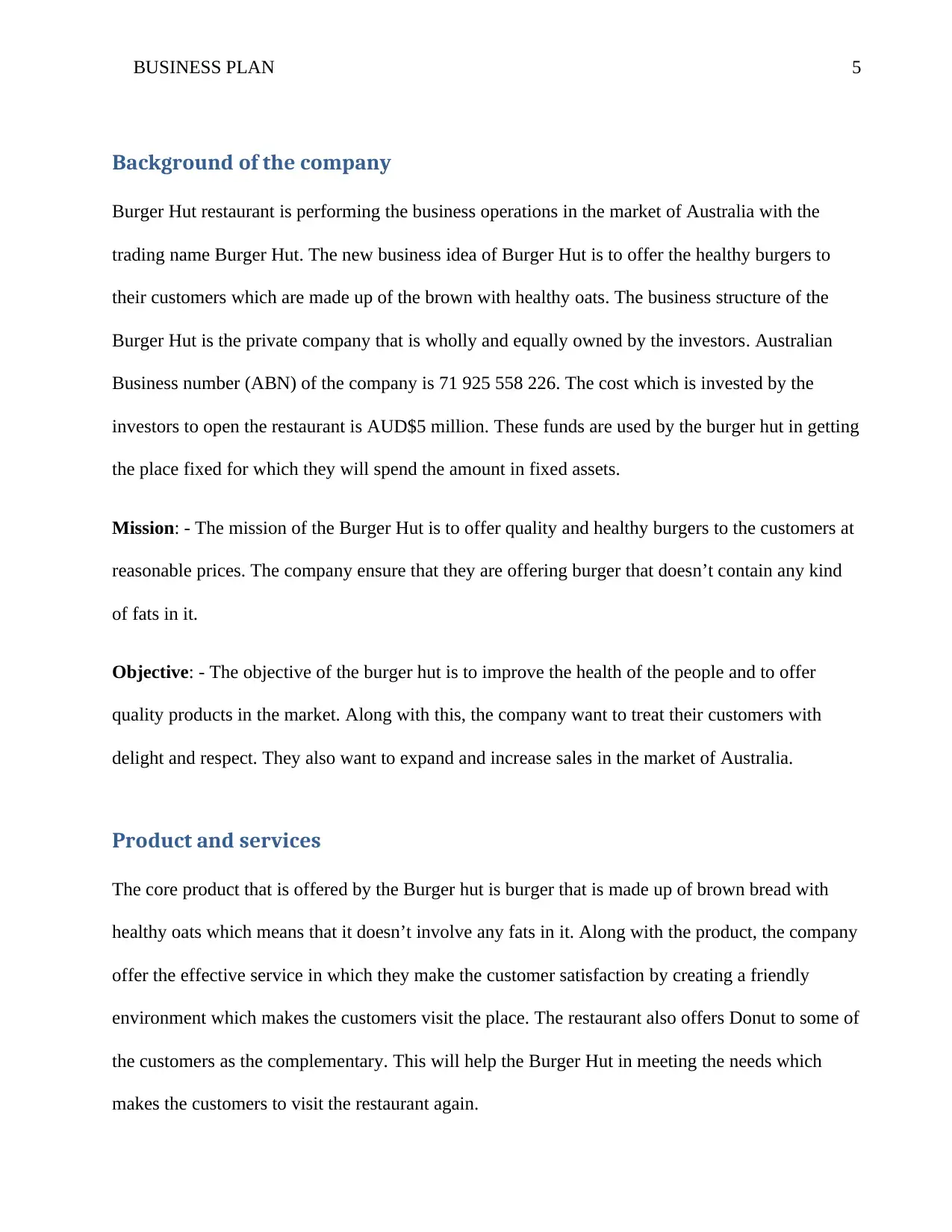
BUSINESS PLAN 5
Background of the company
Burger Hut restaurant is performing the business operations in the market of Australia with the
trading name Burger Hut. The new business idea of Burger Hut is to offer the healthy burgers to
their customers which are made up of the brown with healthy oats. The business structure of the
Burger Hut is the private company that is wholly and equally owned by the investors. Australian
Business number (ABN) of the company is 71 925 558 226. The cost which is invested by the
investors to open the restaurant is AUD$5 million. These funds are used by the burger hut in getting
the place fixed for which they will spend the amount in fixed assets.
Mission: - The mission of the Burger Hut is to offer quality and healthy burgers to the customers at
reasonable prices. The company ensure that they are offering burger that doesn’t contain any kind
of fats in it.
Objective: - The objective of the burger hut is to improve the health of the people and to offer
quality products in the market. Along with this, the company want to treat their customers with
delight and respect. They also want to expand and increase sales in the market of Australia.
Product and services
The core product that is offered by the Burger hut is burger that is made up of brown bread with
healthy oats which means that it doesn’t involve any fats in it. Along with the product, the company
offer the effective service in which they make the customer satisfaction by creating a friendly
environment which makes the customers visit the place. The restaurant also offers Donut to some of
the customers as the complementary. This will help the Burger Hut in meeting the needs which
makes the customers to visit the restaurant again.
Background of the company
Burger Hut restaurant is performing the business operations in the market of Australia with the
trading name Burger Hut. The new business idea of Burger Hut is to offer the healthy burgers to
their customers which are made up of the brown with healthy oats. The business structure of the
Burger Hut is the private company that is wholly and equally owned by the investors. Australian
Business number (ABN) of the company is 71 925 558 226. The cost which is invested by the
investors to open the restaurant is AUD$5 million. These funds are used by the burger hut in getting
the place fixed for which they will spend the amount in fixed assets.
Mission: - The mission of the Burger Hut is to offer quality and healthy burgers to the customers at
reasonable prices. The company ensure that they are offering burger that doesn’t contain any kind
of fats in it.
Objective: - The objective of the burger hut is to improve the health of the people and to offer
quality products in the market. Along with this, the company want to treat their customers with
delight and respect. They also want to expand and increase sales in the market of Australia.
Product and services
The core product that is offered by the Burger hut is burger that is made up of brown bread with
healthy oats which means that it doesn’t involve any fats in it. Along with the product, the company
offer the effective service in which they make the customer satisfaction by creating a friendly
environment which makes the customers visit the place. The restaurant also offers Donut to some of
the customers as the complementary. This will help the Burger Hut in meeting the needs which
makes the customers to visit the restaurant again.
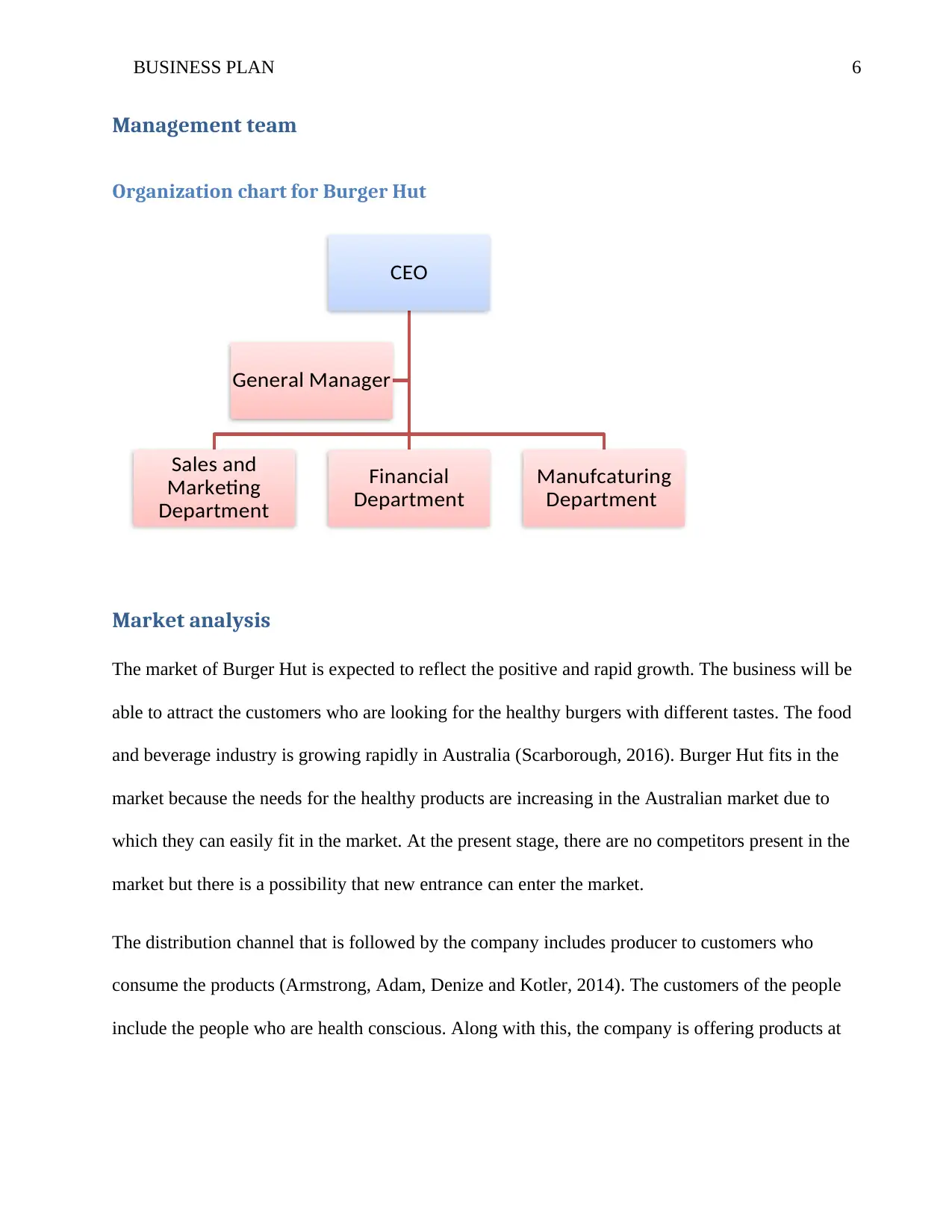
BUSINESS PLAN 6
Management team
Organization chart for Burger Hut
Market analysis
The market of Burger Hut is expected to reflect the positive and rapid growth. The business will be
able to attract the customers who are looking for the healthy burgers with different tastes. The food
and beverage industry is growing rapidly in Australia (Scarborough, 2016). Burger Hut fits in the
market because the needs for the healthy products are increasing in the Australian market due to
which they can easily fit in the market. At the present stage, there are no competitors present in the
market but there is a possibility that new entrance can enter the market.
The distribution channel that is followed by the company includes producer to customers who
consume the products (Armstrong, Adam, Denize and Kotler, 2014). The customers of the people
include the people who are health conscious. Along with this, the company is offering products at
CEO
Sales and
Marketing
Department
Financial
Department
Manufcaturing
Department
General Manager
Management team
Organization chart for Burger Hut
Market analysis
The market of Burger Hut is expected to reflect the positive and rapid growth. The business will be
able to attract the customers who are looking for the healthy burgers with different tastes. The food
and beverage industry is growing rapidly in Australia (Scarborough, 2016). Burger Hut fits in the
market because the needs for the healthy products are increasing in the Australian market due to
which they can easily fit in the market. At the present stage, there are no competitors present in the
market but there is a possibility that new entrance can enter the market.
The distribution channel that is followed by the company includes producer to customers who
consume the products (Armstrong, Adam, Denize and Kotler, 2014). The customers of the people
include the people who are health conscious. Along with this, the company is offering products at
CEO
Sales and
Marketing
Department
Financial
Department
Manufcaturing
Department
General Manager
Paraphrase This Document
Need a fresh take? Get an instant paraphrase of this document with our AI Paraphraser
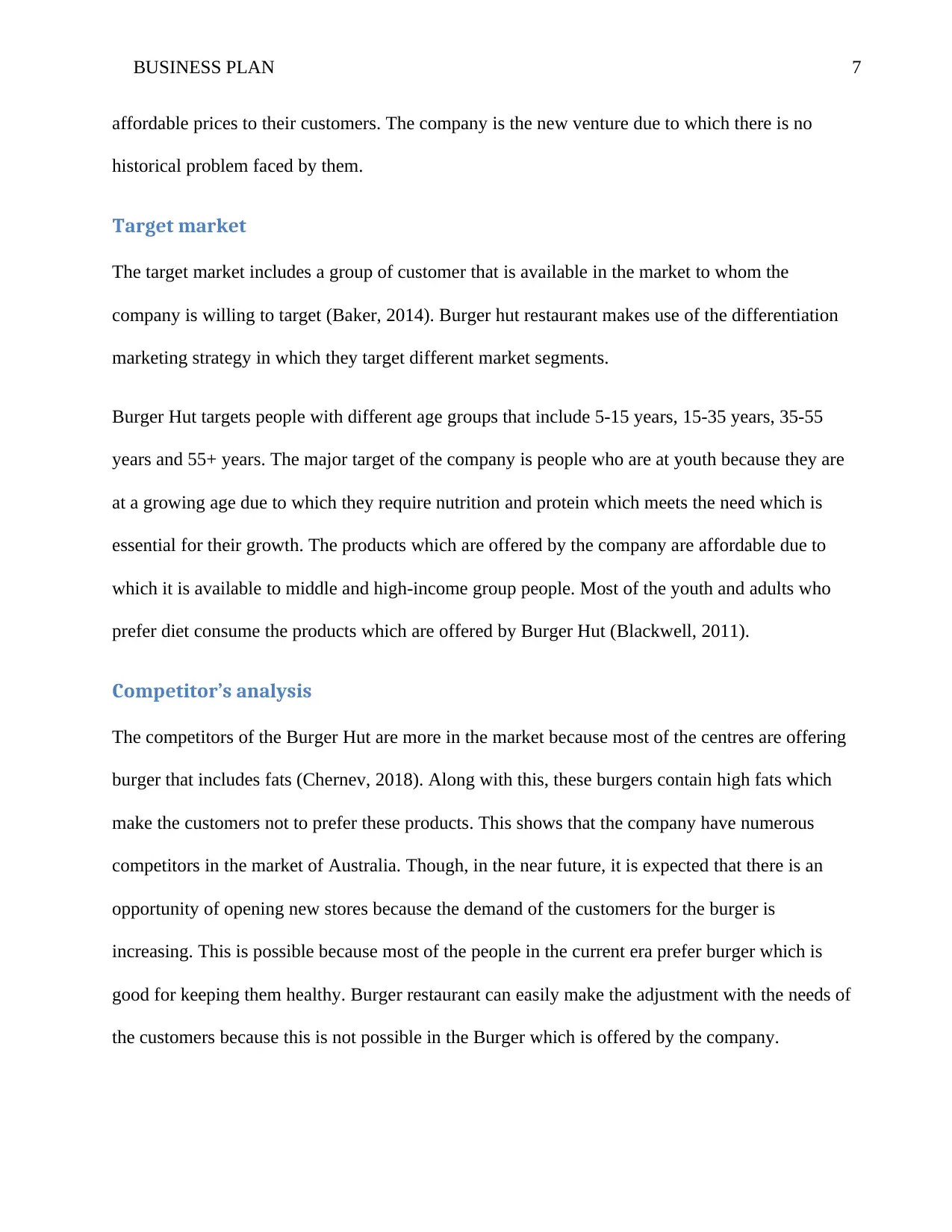
BUSINESS PLAN 7
affordable prices to their customers. The company is the new venture due to which there is no
historical problem faced by them.
Target market
The target market includes a group of customer that is available in the market to whom the
company is willing to target (Baker, 2014). Burger hut restaurant makes use of the differentiation
marketing strategy in which they target different market segments.
Burger Hut targets people with different age groups that include 5-15 years, 15-35 years, 35-55
years and 55+ years. The major target of the company is people who are at youth because they are
at a growing age due to which they require nutrition and protein which meets the need which is
essential for their growth. The products which are offered by the company are affordable due to
which it is available to middle and high-income group people. Most of the youth and adults who
prefer diet consume the products which are offered by Burger Hut (Blackwell, 2011).
Competitor’s analysis
The competitors of the Burger Hut are more in the market because most of the centres are offering
burger that includes fats (Chernev, 2018). Along with this, these burgers contain high fats which
make the customers not to prefer these products. This shows that the company have numerous
competitors in the market of Australia. Though, in the near future, it is expected that there is an
opportunity of opening new stores because the demand of the customers for the burger is
increasing. This is possible because most of the people in the current era prefer burger which is
good for keeping them healthy. Burger restaurant can easily make the adjustment with the needs of
the customers because this is not possible in the Burger which is offered by the company.
affordable prices to their customers. The company is the new venture due to which there is no
historical problem faced by them.
Target market
The target market includes a group of customer that is available in the market to whom the
company is willing to target (Baker, 2014). Burger hut restaurant makes use of the differentiation
marketing strategy in which they target different market segments.
Burger Hut targets people with different age groups that include 5-15 years, 15-35 years, 35-55
years and 55+ years. The major target of the company is people who are at youth because they are
at a growing age due to which they require nutrition and protein which meets the need which is
essential for their growth. The products which are offered by the company are affordable due to
which it is available to middle and high-income group people. Most of the youth and adults who
prefer diet consume the products which are offered by Burger Hut (Blackwell, 2011).
Competitor’s analysis
The competitors of the Burger Hut are more in the market because most of the centres are offering
burger that includes fats (Chernev, 2018). Along with this, these burgers contain high fats which
make the customers not to prefer these products. This shows that the company have numerous
competitors in the market of Australia. Though, in the near future, it is expected that there is an
opportunity of opening new stores because the demand of the customers for the burger is
increasing. This is possible because most of the people in the current era prefer burger which is
good for keeping them healthy. Burger restaurant can easily make the adjustment with the needs of
the customers because this is not possible in the Burger which is offered by the company.
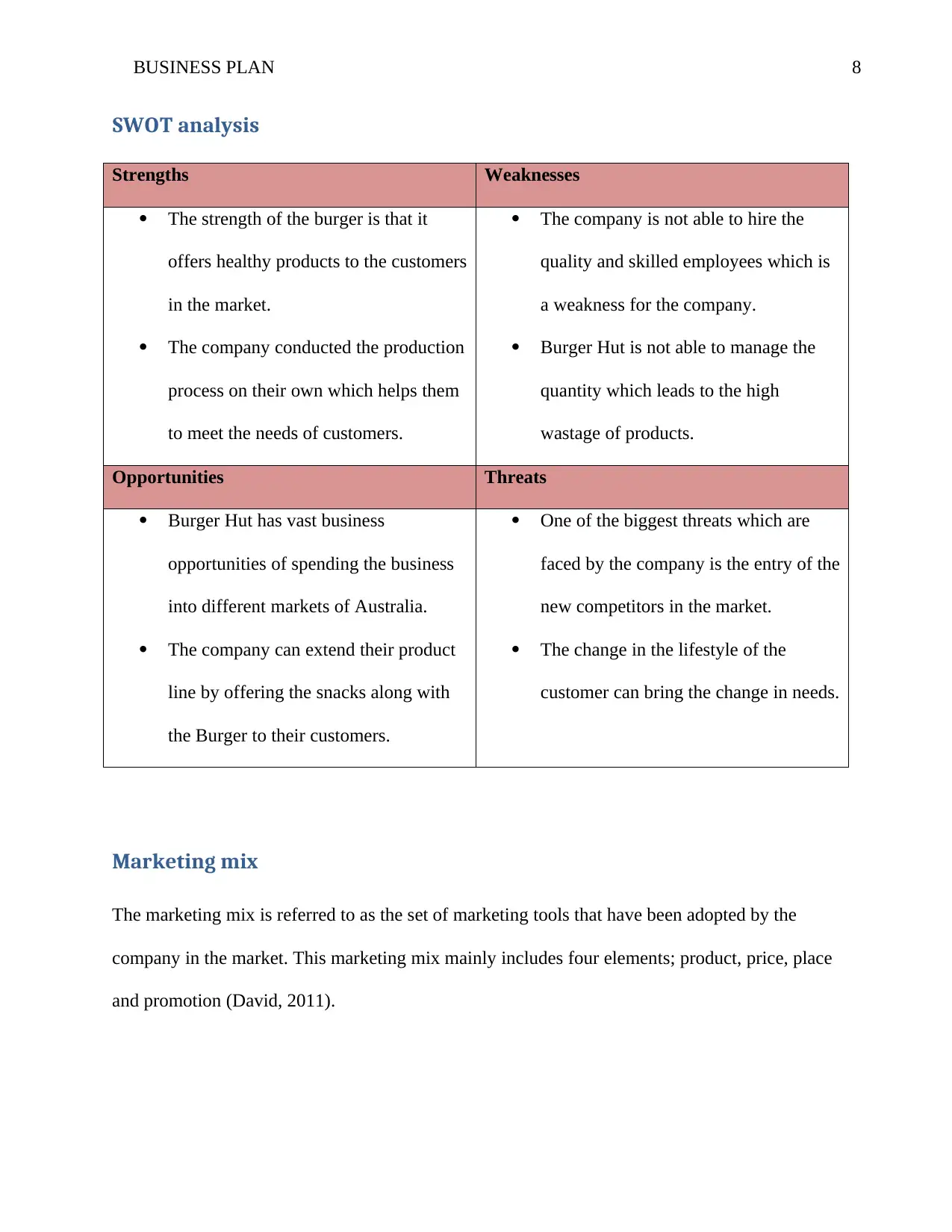
BUSINESS PLAN 8
SWOT analysis
Strengths Weaknesses
The strength of the burger is that it
offers healthy products to the customers
in the market.
The company conducted the production
process on their own which helps them
to meet the needs of customers.
The company is not able to hire the
quality and skilled employees which is
a weakness for the company.
Burger Hut is not able to manage the
quantity which leads to the high
wastage of products.
Opportunities Threats
Burger Hut has vast business
opportunities of spending the business
into different markets of Australia.
The company can extend their product
line by offering the snacks along with
the Burger to their customers.
One of the biggest threats which are
faced by the company is the entry of the
new competitors in the market.
The change in the lifestyle of the
customer can bring the change in needs.
Marketing mix
The marketing mix is referred to as the set of marketing tools that have been adopted by the
company in the market. This marketing mix mainly includes four elements; product, price, place
and promotion (David, 2011).
SWOT analysis
Strengths Weaknesses
The strength of the burger is that it
offers healthy products to the customers
in the market.
The company conducted the production
process on their own which helps them
to meet the needs of customers.
The company is not able to hire the
quality and skilled employees which is
a weakness for the company.
Burger Hut is not able to manage the
quantity which leads to the high
wastage of products.
Opportunities Threats
Burger Hut has vast business
opportunities of spending the business
into different markets of Australia.
The company can extend their product
line by offering the snacks along with
the Burger to their customers.
One of the biggest threats which are
faced by the company is the entry of the
new competitors in the market.
The change in the lifestyle of the
customer can bring the change in needs.
Marketing mix
The marketing mix is referred to as the set of marketing tools that have been adopted by the
company in the market. This marketing mix mainly includes four elements; product, price, place
and promotion (David, 2011).
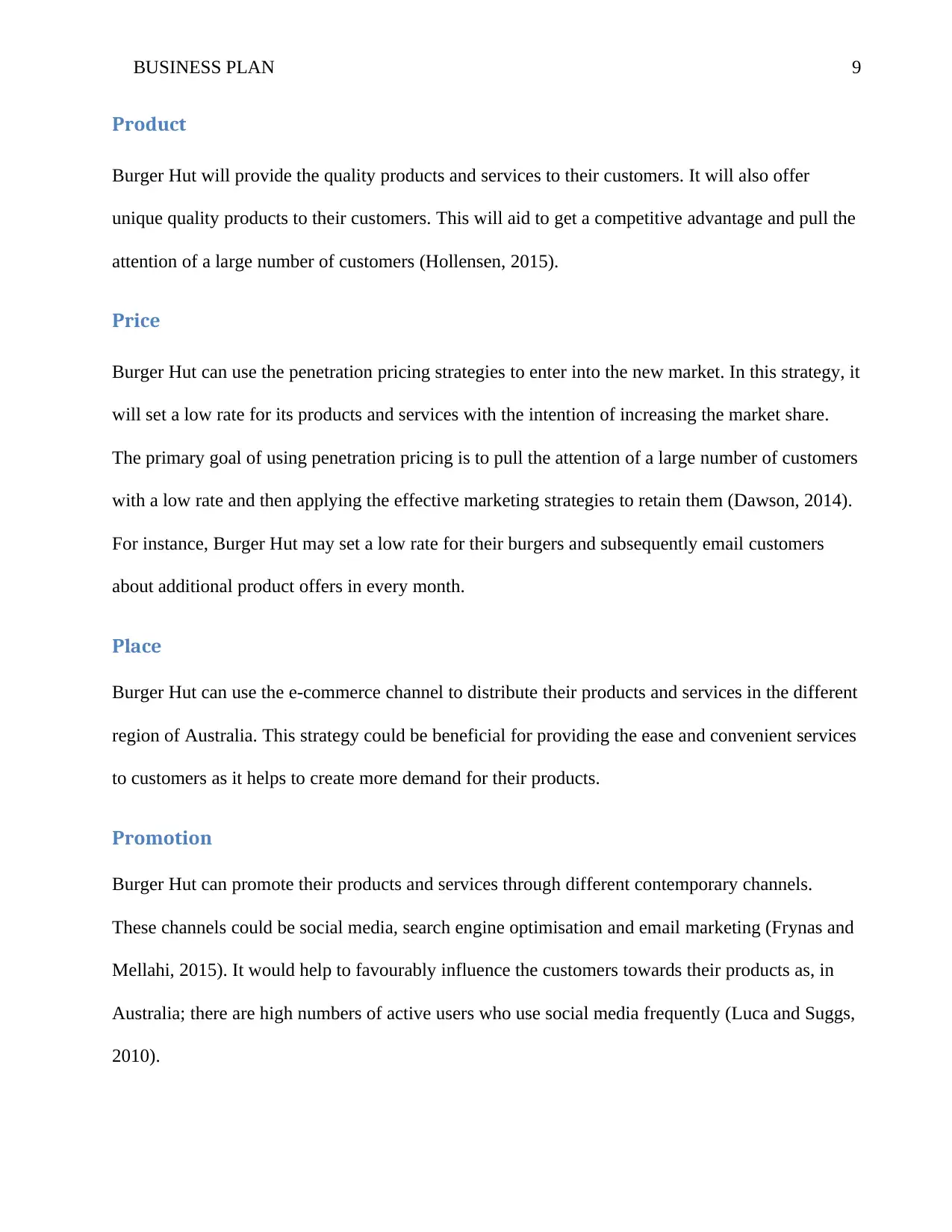
BUSINESS PLAN 9
Product
Burger Hut will provide the quality products and services to their customers. It will also offer
unique quality products to their customers. This will aid to get a competitive advantage and pull the
attention of a large number of customers (Hollensen, 2015).
Price
Burger Hut can use the penetration pricing strategies to enter into the new market. In this strategy, it
will set a low rate for its products and services with the intention of increasing the market share.
The primary goal of using penetration pricing is to pull the attention of a large number of customers
with a low rate and then applying the effective marketing strategies to retain them (Dawson, 2014).
For instance, Burger Hut may set a low rate for their burgers and subsequently email customers
about additional product offers in every month.
Place
Burger Hut can use the e-commerce channel to distribute their products and services in the different
region of Australia. This strategy could be beneficial for providing the ease and convenient services
to customers as it helps to create more demand for their products.
Promotion
Burger Hut can promote their products and services through different contemporary channels.
These channels could be social media, search engine optimisation and email marketing (Frynas and
Mellahi, 2015). It would help to favourably influence the customers towards their products as, in
Australia; there are high numbers of active users who use social media frequently (Luca and Suggs,
2010).
Product
Burger Hut will provide the quality products and services to their customers. It will also offer
unique quality products to their customers. This will aid to get a competitive advantage and pull the
attention of a large number of customers (Hollensen, 2015).
Price
Burger Hut can use the penetration pricing strategies to enter into the new market. In this strategy, it
will set a low rate for its products and services with the intention of increasing the market share.
The primary goal of using penetration pricing is to pull the attention of a large number of customers
with a low rate and then applying the effective marketing strategies to retain them (Dawson, 2014).
For instance, Burger Hut may set a low rate for their burgers and subsequently email customers
about additional product offers in every month.
Place
Burger Hut can use the e-commerce channel to distribute their products and services in the different
region of Australia. This strategy could be beneficial for providing the ease and convenient services
to customers as it helps to create more demand for their products.
Promotion
Burger Hut can promote their products and services through different contemporary channels.
These channels could be social media, search engine optimisation and email marketing (Frynas and
Mellahi, 2015). It would help to favourably influence the customers towards their products as, in
Australia; there are high numbers of active users who use social media frequently (Luca and Suggs,
2010).
Secure Best Marks with AI Grader
Need help grading? Try our AI Grader for instant feedback on your assignments.
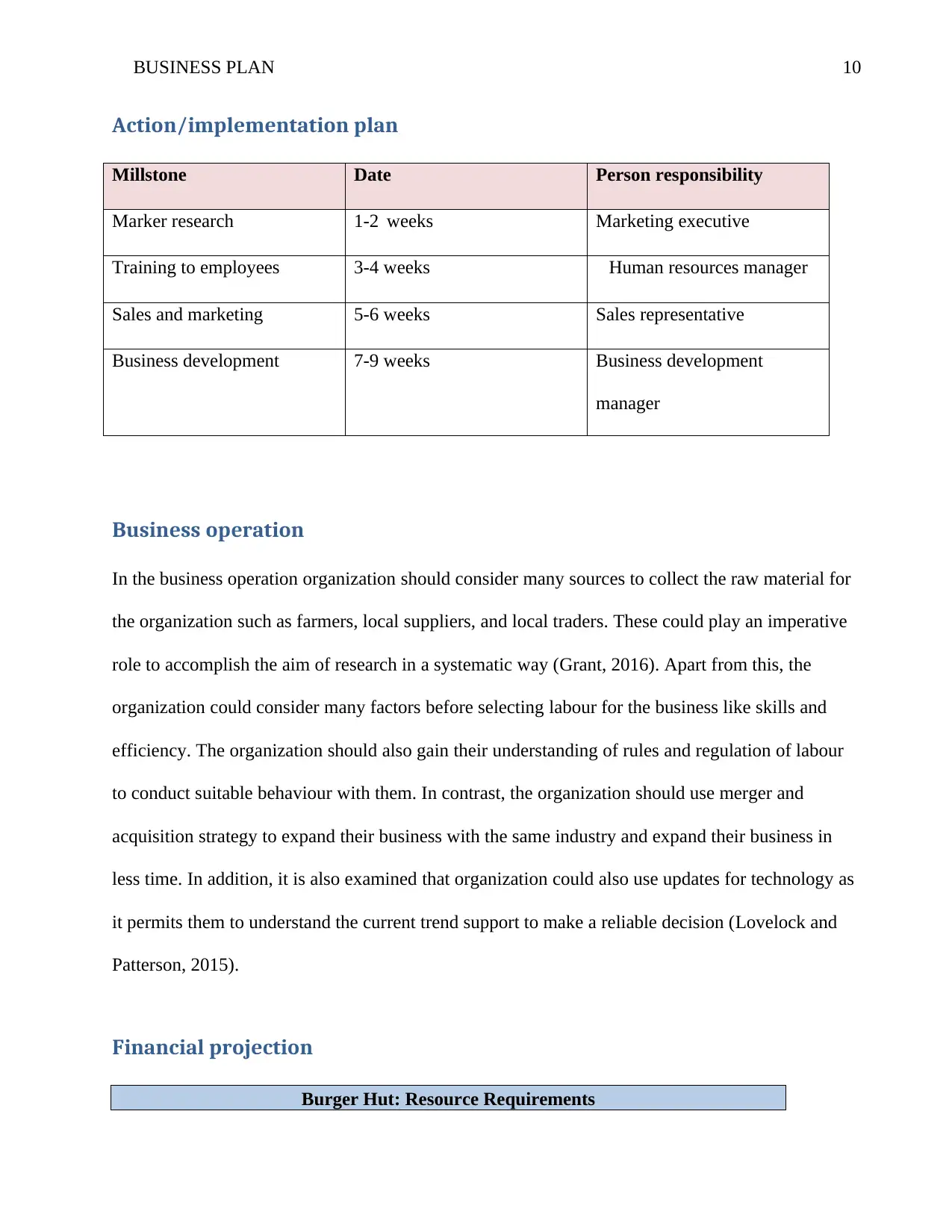
BUSINESS PLAN 10
Action/implementation plan
Millstone Date Person responsibility
Marker research 1-2 weeks Marketing executive
Training to employees 3-4 weeks Human resources manager
Sales and marketing 5-6 weeks Sales representative
Business development 7-9 weeks Business development
manager
Business operation
In the business operation organization should consider many sources to collect the raw material for
the organization such as farmers, local suppliers, and local traders. These could play an imperative
role to accomplish the aim of research in a systematic way (Grant, 2016). Apart from this, the
organization could consider many factors before selecting labour for the business like skills and
efficiency. The organization should also gain their understanding of rules and regulation of labour
to conduct suitable behaviour with them. In contrast, the organization should use merger and
acquisition strategy to expand their business with the same industry and expand their business in
less time. In addition, it is also examined that organization could also use updates for technology as
it permits them to understand the current trend support to make a reliable decision (Lovelock and
Patterson, 2015).
Financial projection
Burger Hut: Resource Requirements
Action/implementation plan
Millstone Date Person responsibility
Marker research 1-2 weeks Marketing executive
Training to employees 3-4 weeks Human resources manager
Sales and marketing 5-6 weeks Sales representative
Business development 7-9 weeks Business development
manager
Business operation
In the business operation organization should consider many sources to collect the raw material for
the organization such as farmers, local suppliers, and local traders. These could play an imperative
role to accomplish the aim of research in a systematic way (Grant, 2016). Apart from this, the
organization could consider many factors before selecting labour for the business like skills and
efficiency. The organization should also gain their understanding of rules and regulation of labour
to conduct suitable behaviour with them. In contrast, the organization should use merger and
acquisition strategy to expand their business with the same industry and expand their business in
less time. In addition, it is also examined that organization could also use updates for technology as
it permits them to understand the current trend support to make a reliable decision (Lovelock and
Patterson, 2015).
Financial projection
Burger Hut: Resource Requirements
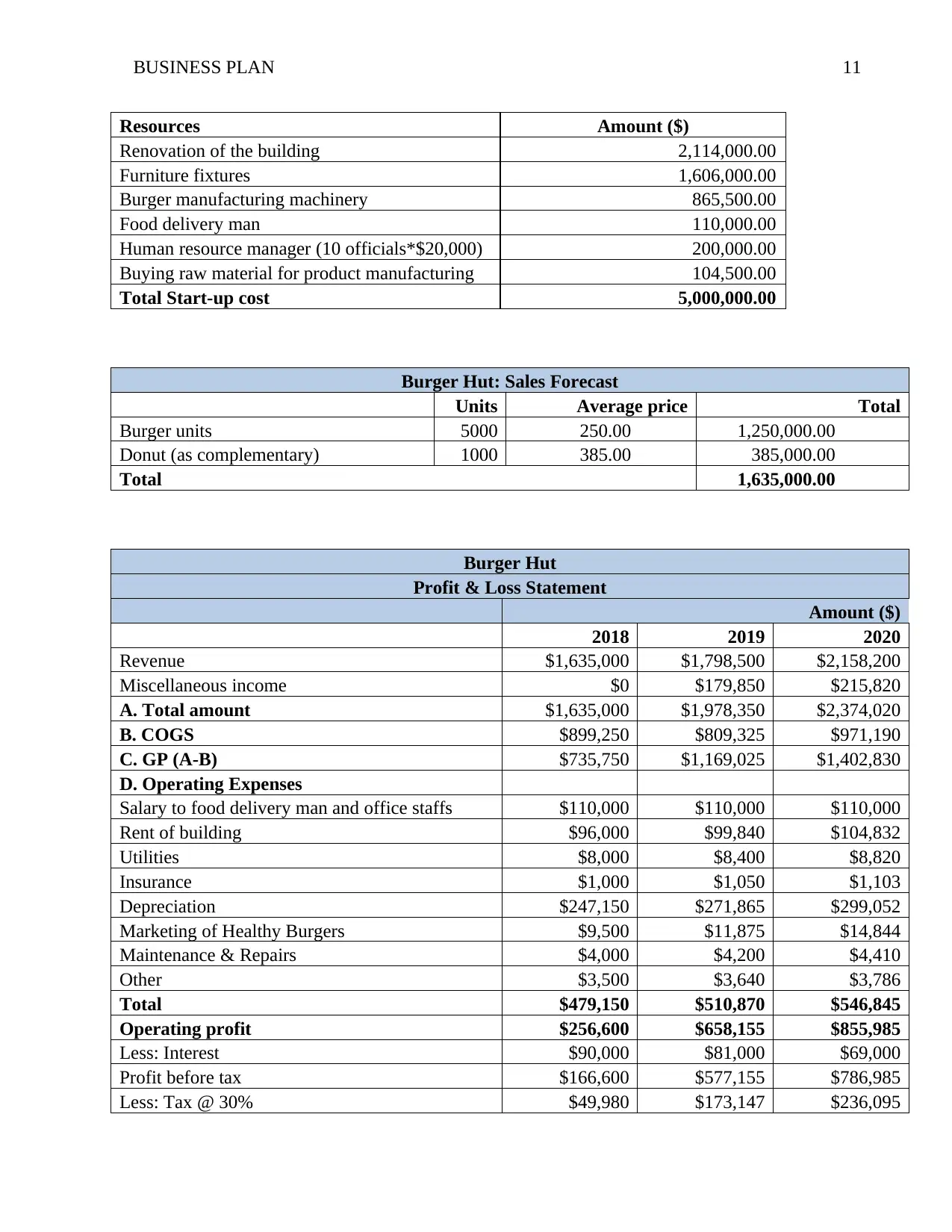
BUSINESS PLAN 11
Resources Amount ($)
Renovation of the building 2,114,000.00
Furniture fixtures 1,606,000.00
Burger manufacturing machinery 865,500.00
Food delivery man 110,000.00
Human resource manager (10 officials*$20,000) 200,000.00
Buying raw material for product manufacturing 104,500.00
Total Start-up cost 5,000,000.00
Burger Hut: Sales Forecast
Units Average price Total
Burger units 5000 250.00 1,250,000.00
Donut (as complementary) 1000 385.00 385,000.00
Total 1,635,000.00
Burger Hut
Profit & Loss Statement
Amount ($)
2018 2019 2020
Revenue $1,635,000 $1,798,500 $2,158,200
Miscellaneous income $0 $179,850 $215,820
A. Total amount $1,635,000 $1,978,350 $2,374,020
B. COGS $899,250 $809,325 $971,190
C. GP (A-B) $735,750 $1,169,025 $1,402,830
D. Operating Expenses
Salary to food delivery man and office staffs $110,000 $110,000 $110,000
Rent of building $96,000 $99,840 $104,832
Utilities $8,000 $8,400 $8,820
Insurance $1,000 $1,050 $1,103
Depreciation $247,150 $271,865 $299,052
Marketing of Healthy Burgers $9,500 $11,875 $14,844
Maintenance & Repairs $4,000 $4,200 $4,410
Other $3,500 $3,640 $3,786
Total $479,150 $510,870 $546,845
Operating profit $256,600 $658,155 $855,985
Less: Interest $90,000 $81,000 $69,000
Profit before tax $166,600 $577,155 $786,985
Less: Tax @ 30% $49,980 $173,147 $236,095
Resources Amount ($)
Renovation of the building 2,114,000.00
Furniture fixtures 1,606,000.00
Burger manufacturing machinery 865,500.00
Food delivery man 110,000.00
Human resource manager (10 officials*$20,000) 200,000.00
Buying raw material for product manufacturing 104,500.00
Total Start-up cost 5,000,000.00
Burger Hut: Sales Forecast
Units Average price Total
Burger units 5000 250.00 1,250,000.00
Donut (as complementary) 1000 385.00 385,000.00
Total 1,635,000.00
Burger Hut
Profit & Loss Statement
Amount ($)
2018 2019 2020
Revenue $1,635,000 $1,798,500 $2,158,200
Miscellaneous income $0 $179,850 $215,820
A. Total amount $1,635,000 $1,978,350 $2,374,020
B. COGS $899,250 $809,325 $971,190
C. GP (A-B) $735,750 $1,169,025 $1,402,830
D. Operating Expenses
Salary to food delivery man and office staffs $110,000 $110,000 $110,000
Rent of building $96,000 $99,840 $104,832
Utilities $8,000 $8,400 $8,820
Insurance $1,000 $1,050 $1,103
Depreciation $247,150 $271,865 $299,052
Marketing of Healthy Burgers $9,500 $11,875 $14,844
Maintenance & Repairs $4,000 $4,200 $4,410
Other $3,500 $3,640 $3,786
Total $479,150 $510,870 $546,845
Operating profit $256,600 $658,155 $855,985
Less: Interest $90,000 $81,000 $69,000
Profit before tax $166,600 $577,155 $786,985
Less: Tax @ 30% $49,980 $173,147 $236,095
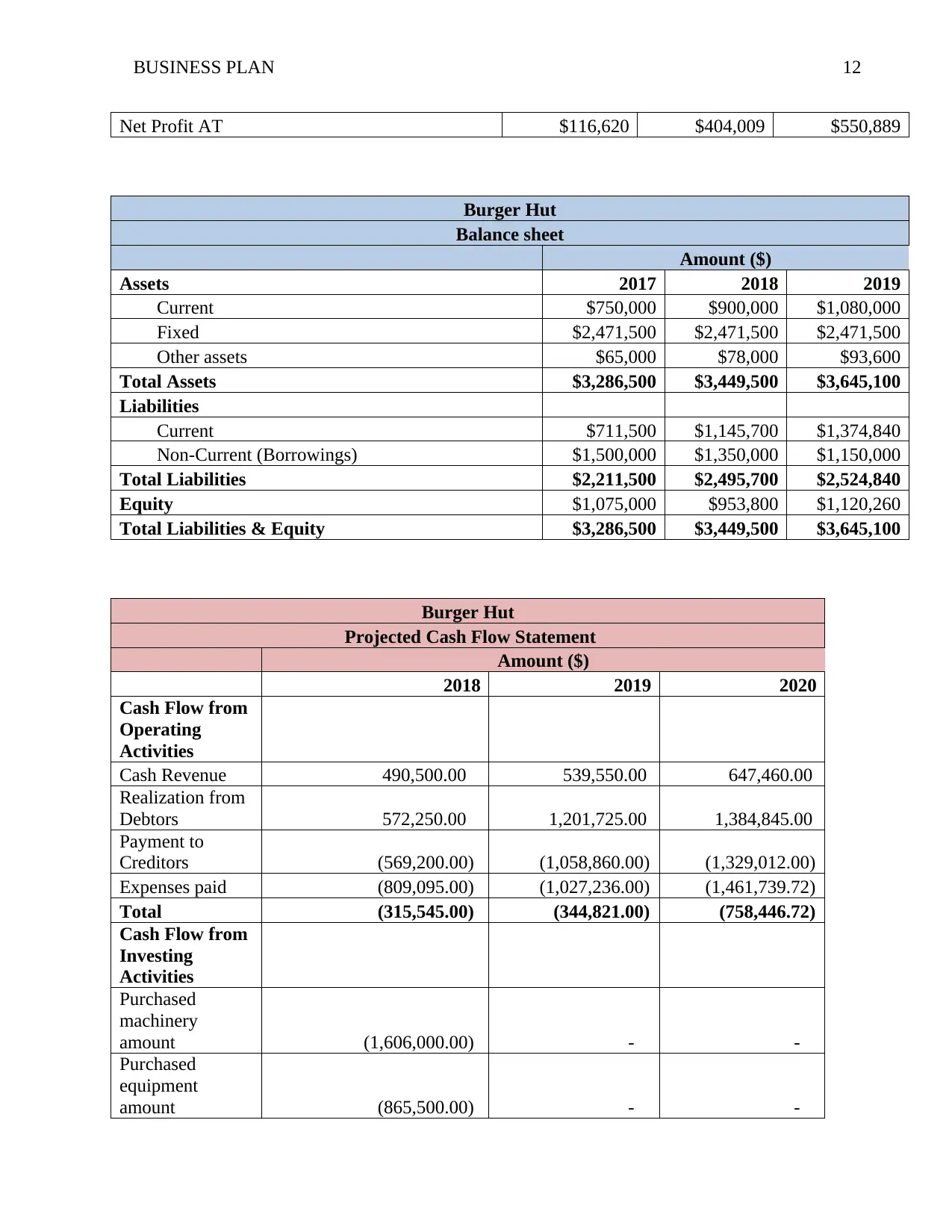
BUSINESS PLAN 12
Net Profit AT $116,620 $404,009 $550,889
Burger Hut
Balance sheet
Amount ($)
Assets 2017 2018 2019
Current $750,000 $900,000 $1,080,000
Fixed $2,471,500 $2,471,500 $2,471,500
Other assets $65,000 $78,000 $93,600
Total Assets $3,286,500 $3,449,500 $3,645,100
Liabilities
Current $711,500 $1,145,700 $1,374,840
Non-Current (Borrowings) $1,500,000 $1,350,000 $1,150,000
Total Liabilities $2,211,500 $2,495,700 $2,524,840
Equity $1,075,000 $953,800 $1,120,260
Total Liabilities & Equity $3,286,500 $3,449,500 $3,645,100
Burger Hut
Projected Cash Flow Statement
Amount ($)
2018 2019 2020
Cash Flow from
Operating
Activities
Cash Revenue 490,500.00 539,550.00 647,460.00
Realization from
Debtors 572,250.00 1,201,725.00 1,384,845.00
Payment to
Creditors (569,200.00) (1,058,860.00) (1,329,012.00)
Expenses paid (809,095.00) (1,027,236.00) (1,461,739.72)
Total (315,545.00) (344,821.00) (758,446.72)
Cash Flow from
Investing
Activities
Purchased
machinery
amount (1,606,000.00) - -
Purchased
equipment
amount (865,500.00) - -
Net Profit AT $116,620 $404,009 $550,889
Burger Hut
Balance sheet
Amount ($)
Assets 2017 2018 2019
Current $750,000 $900,000 $1,080,000
Fixed $2,471,500 $2,471,500 $2,471,500
Other assets $65,000 $78,000 $93,600
Total Assets $3,286,500 $3,449,500 $3,645,100
Liabilities
Current $711,500 $1,145,700 $1,374,840
Non-Current (Borrowings) $1,500,000 $1,350,000 $1,150,000
Total Liabilities $2,211,500 $2,495,700 $2,524,840
Equity $1,075,000 $953,800 $1,120,260
Total Liabilities & Equity $3,286,500 $3,449,500 $3,645,100
Burger Hut
Projected Cash Flow Statement
Amount ($)
2018 2019 2020
Cash Flow from
Operating
Activities
Cash Revenue 490,500.00 539,550.00 647,460.00
Realization from
Debtors 572,250.00 1,201,725.00 1,384,845.00
Payment to
Creditors (569,200.00) (1,058,860.00) (1,329,012.00)
Expenses paid (809,095.00) (1,027,236.00) (1,461,739.72)
Total (315,545.00) (344,821.00) (758,446.72)
Cash Flow from
Investing
Activities
Purchased
machinery
amount (1,606,000.00) - -
Purchased
equipment
amount (865,500.00) - -
Paraphrase This Document
Need a fresh take? Get an instant paraphrase of this document with our AI Paraphraser
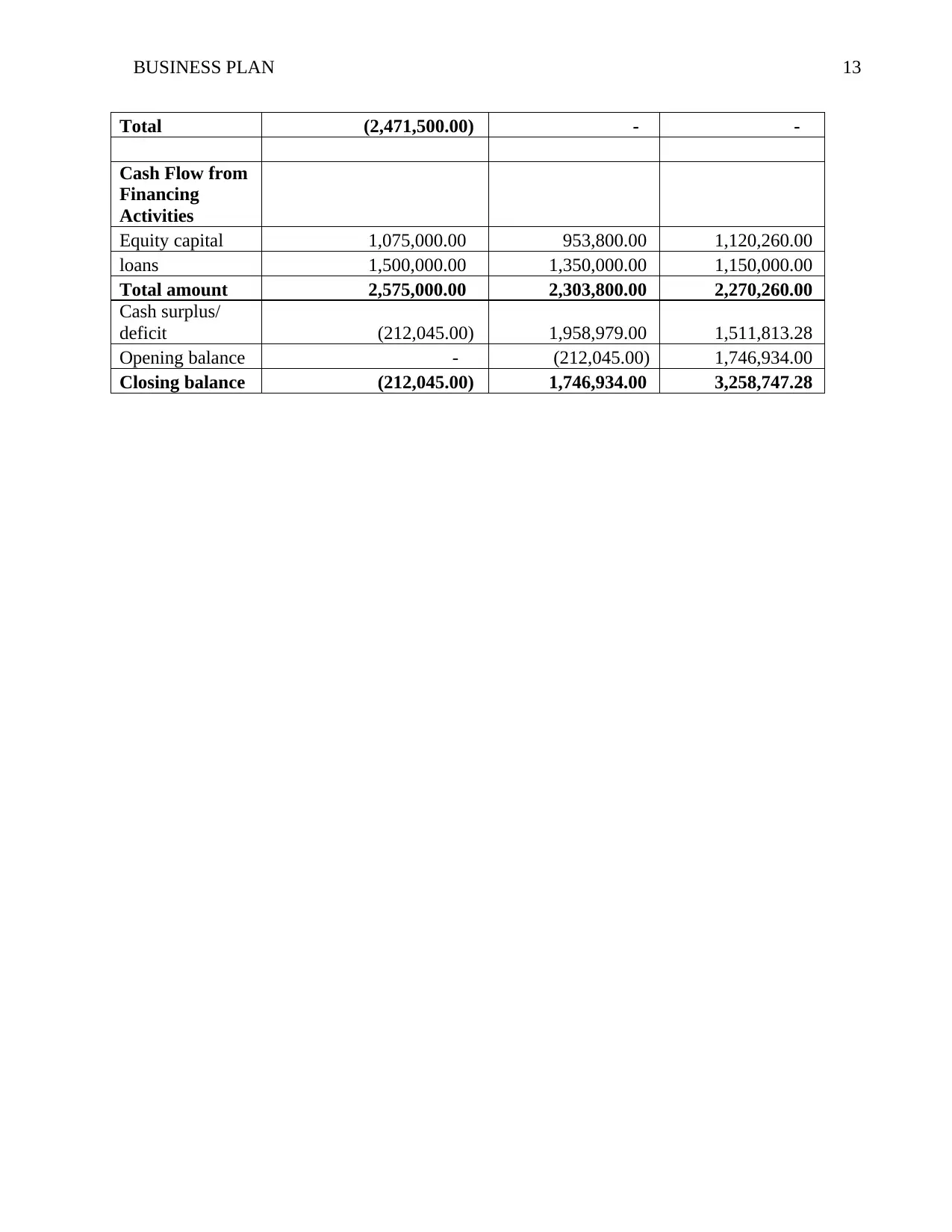
BUSINESS PLAN 13
Total (2,471,500.00) - -
Cash Flow from
Financing
Activities
Equity capital 1,075,000.00 953,800.00 1,120,260.00
loans 1,500,000.00 1,350,000.00 1,150,000.00
Total amount 2,575,000.00 2,303,800.00 2,270,260.00
Cash surplus/
deficit (212,045.00) 1,958,979.00 1,511,813.28
Opening balance - (212,045.00) 1,746,934.00
Closing balance (212,045.00) 1,746,934.00 3,258,747.28
Total (2,471,500.00) - -
Cash Flow from
Financing
Activities
Equity capital 1,075,000.00 953,800.00 1,120,260.00
loans 1,500,000.00 1,350,000.00 1,150,000.00
Total amount 2,575,000.00 2,303,800.00 2,270,260.00
Cash surplus/
deficit (212,045.00) 1,958,979.00 1,511,813.28
Opening balance - (212,045.00) 1,746,934.00
Closing balance (212,045.00) 1,746,934.00 3,258,747.28
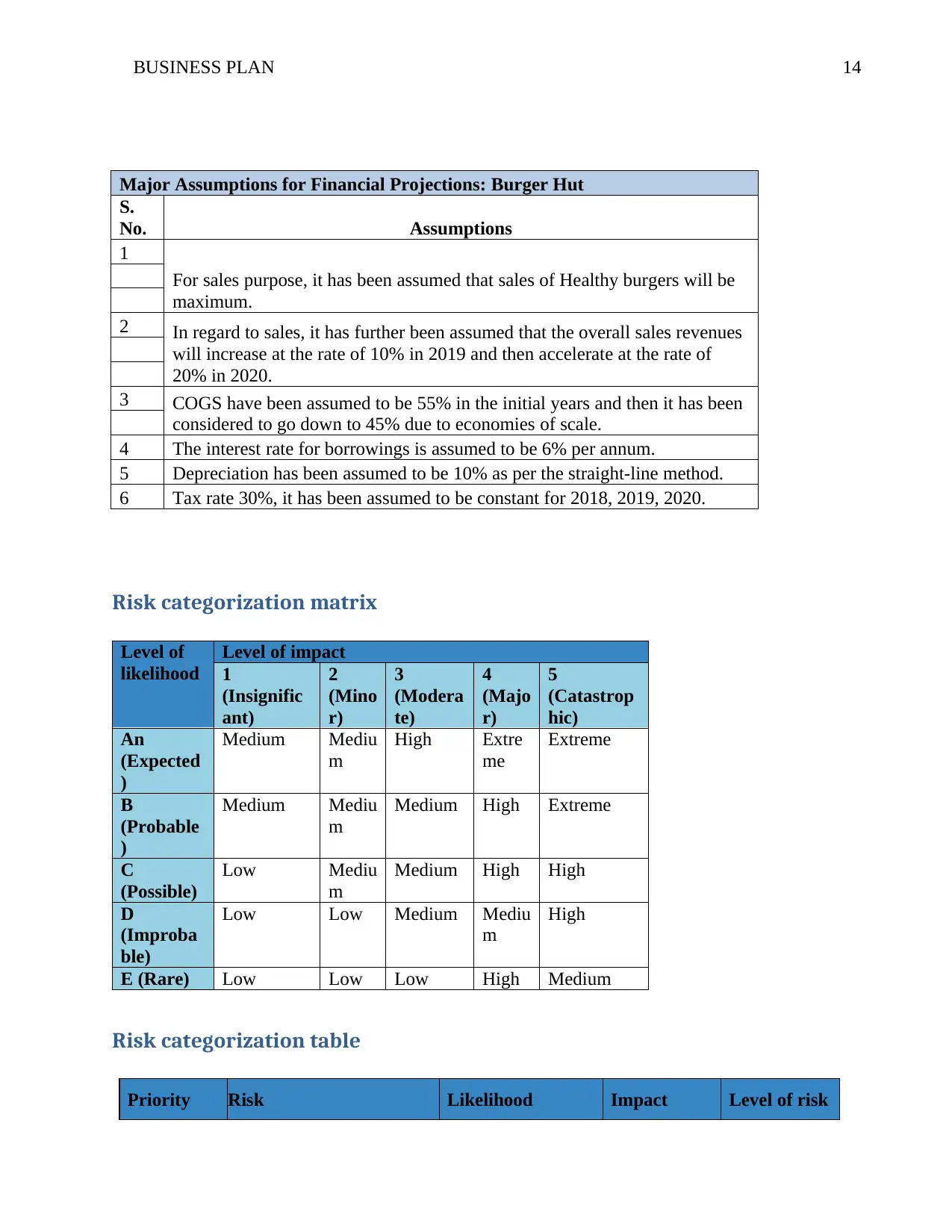
BUSINESS PLAN 14
Major Assumptions for Financial Projections: Burger Hut
S.
No. Assumptions
1
For sales purpose, it has been assumed that sales of Healthy burgers will be
maximum.
2 In regard to sales, it has further been assumed that the overall sales revenues
will increase at the rate of 10% in 2019 and then accelerate at the rate of
20% in 2020.
3 COGS have been assumed to be 55% in the initial years and then it has been
considered to go down to 45% due to economies of scale.
4 The interest rate for borrowings is assumed to be 6% per annum.
5 Depreciation has been assumed to be 10% as per the straight-line method.
6 Tax rate 30%, it has been assumed to be constant for 2018, 2019, 2020.
Risk categorization matrix
Level of
likelihood
Level of impact
1
(Insignific
ant)
2
(Mino
r)
3
(Modera
te)
4
(Majo
r)
5
(Catastrop
hic)
An
(Expected
)
Medium Mediu
m
High Extre
me
Extreme
B
(Probable
)
Medium Mediu
m
Medium High Extreme
C
(Possible)
Low Mediu
m
Medium High High
D
(Improba
ble)
Low Low Medium Mediu
m
High
E (Rare) Low Low Low High Medium
Risk categorization table
Priority Risk Likelihood Impact Level of risk
Major Assumptions for Financial Projections: Burger Hut
S.
No. Assumptions
1
For sales purpose, it has been assumed that sales of Healthy burgers will be
maximum.
2 In regard to sales, it has further been assumed that the overall sales revenues
will increase at the rate of 10% in 2019 and then accelerate at the rate of
20% in 2020.
3 COGS have been assumed to be 55% in the initial years and then it has been
considered to go down to 45% due to economies of scale.
4 The interest rate for borrowings is assumed to be 6% per annum.
5 Depreciation has been assumed to be 10% as per the straight-line method.
6 Tax rate 30%, it has been assumed to be constant for 2018, 2019, 2020.
Risk categorization matrix
Level of
likelihood
Level of impact
1
(Insignific
ant)
2
(Mino
r)
3
(Modera
te)
4
(Majo
r)
5
(Catastrop
hic)
An
(Expected
)
Medium Mediu
m
High Extre
me
Extreme
B
(Probable
)
Medium Mediu
m
Medium High Extreme
C
(Possible)
Low Mediu
m
Medium High High
D
(Improba
ble)
Low Low Medium Mediu
m
High
E (Rare) Low Low Low High Medium
Risk categorization table
Priority Risk Likelihood Impact Level of risk
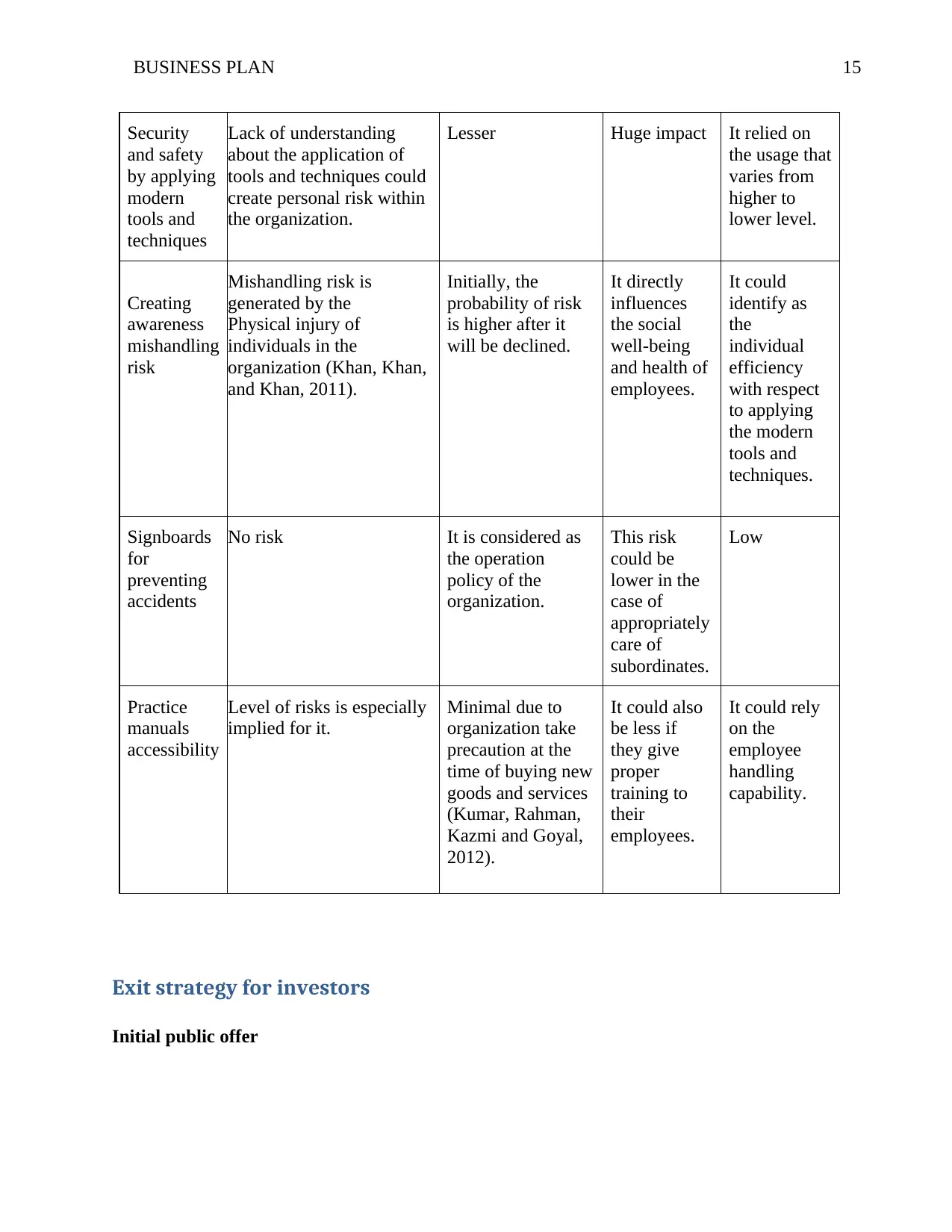
BUSINESS PLAN 15
Security
and safety
by applying
modern
tools and
techniques
Lack of understanding
about the application of
tools and techniques could
create personal risk within
the organization.
Lesser Huge impact It relied on
the usage that
varies from
higher to
lower level.
Creating
awareness
mishandling
risk
Mishandling risk is
generated by the
Physical injury of
individuals in the
organization (Khan, Khan,
and Khan, 2011).
Initially, the
probability of risk
is higher after it
will be declined.
It directly
influences
the social
well-being
and health of
employees.
It could
identify as
the
individual
efficiency
with respect
to applying
the modern
tools and
techniques.
Signboards
for
preventing
accidents
No risk It is considered as
the operation
policy of the
organization.
This risk
could be
lower in the
case of
appropriately
care of
subordinates.
Low
Practice
manuals
accessibility
Level of risks is especially
implied for it.
Minimal due to
organization take
precaution at the
time of buying new
goods and services
(Kumar, Rahman,
Kazmi and Goyal,
2012).
It could also
be less if
they give
proper
training to
their
employees.
It could rely
on the
employee
handling
capability.
Exit strategy for investors
Initial public offer
Security
and safety
by applying
modern
tools and
techniques
Lack of understanding
about the application of
tools and techniques could
create personal risk within
the organization.
Lesser Huge impact It relied on
the usage that
varies from
higher to
lower level.
Creating
awareness
mishandling
risk
Mishandling risk is
generated by the
Physical injury of
individuals in the
organization (Khan, Khan,
and Khan, 2011).
Initially, the
probability of risk
is higher after it
will be declined.
It directly
influences
the social
well-being
and health of
employees.
It could
identify as
the
individual
efficiency
with respect
to applying
the modern
tools and
techniques.
Signboards
for
preventing
accidents
No risk It is considered as
the operation
policy of the
organization.
This risk
could be
lower in the
case of
appropriately
care of
subordinates.
Low
Practice
manuals
accessibility
Level of risks is especially
implied for it.
Minimal due to
organization take
precaution at the
time of buying new
goods and services
(Kumar, Rahman,
Kazmi and Goyal,
2012).
It could also
be less if
they give
proper
training to
their
employees.
It could rely
on the
employee
handling
capability.
Exit strategy for investors
Initial public offer
Secure Best Marks with AI Grader
Need help grading? Try our AI Grader for instant feedback on your assignments.
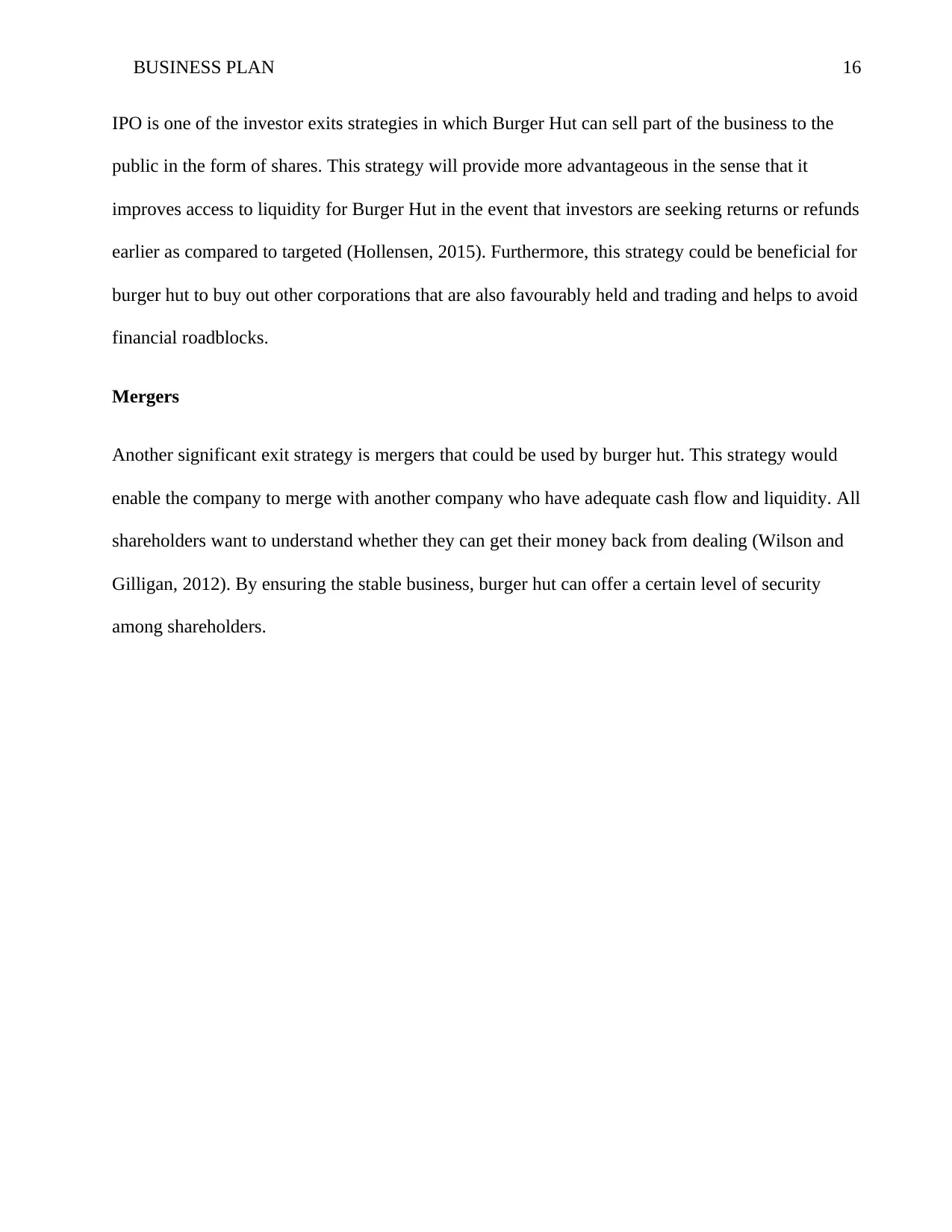
BUSINESS PLAN 16
IPO is one of the investor exits strategies in which Burger Hut can sell part of the business to the
public in the form of shares. This strategy will provide more advantageous in the sense that it
improves access to liquidity for Burger Hut in the event that investors are seeking returns or refunds
earlier as compared to targeted (Hollensen, 2015). Furthermore, this strategy could be beneficial for
burger hut to buy out other corporations that are also favourably held and trading and helps to avoid
financial roadblocks.
Mergers
Another significant exit strategy is mergers that could be used by burger hut. This strategy would
enable the company to merge with another company who have adequate cash flow and liquidity. All
shareholders want to understand whether they can get their money back from dealing (Wilson and
Gilligan, 2012). By ensuring the stable business, burger hut can offer a certain level of security
among shareholders.
IPO is one of the investor exits strategies in which Burger Hut can sell part of the business to the
public in the form of shares. This strategy will provide more advantageous in the sense that it
improves access to liquidity for Burger Hut in the event that investors are seeking returns or refunds
earlier as compared to targeted (Hollensen, 2015). Furthermore, this strategy could be beneficial for
burger hut to buy out other corporations that are also favourably held and trading and helps to avoid
financial roadblocks.
Mergers
Another significant exit strategy is mergers that could be used by burger hut. This strategy would
enable the company to merge with another company who have adequate cash flow and liquidity. All
shareholders want to understand whether they can get their money back from dealing (Wilson and
Gilligan, 2012). By ensuring the stable business, burger hut can offer a certain level of security
among shareholders.
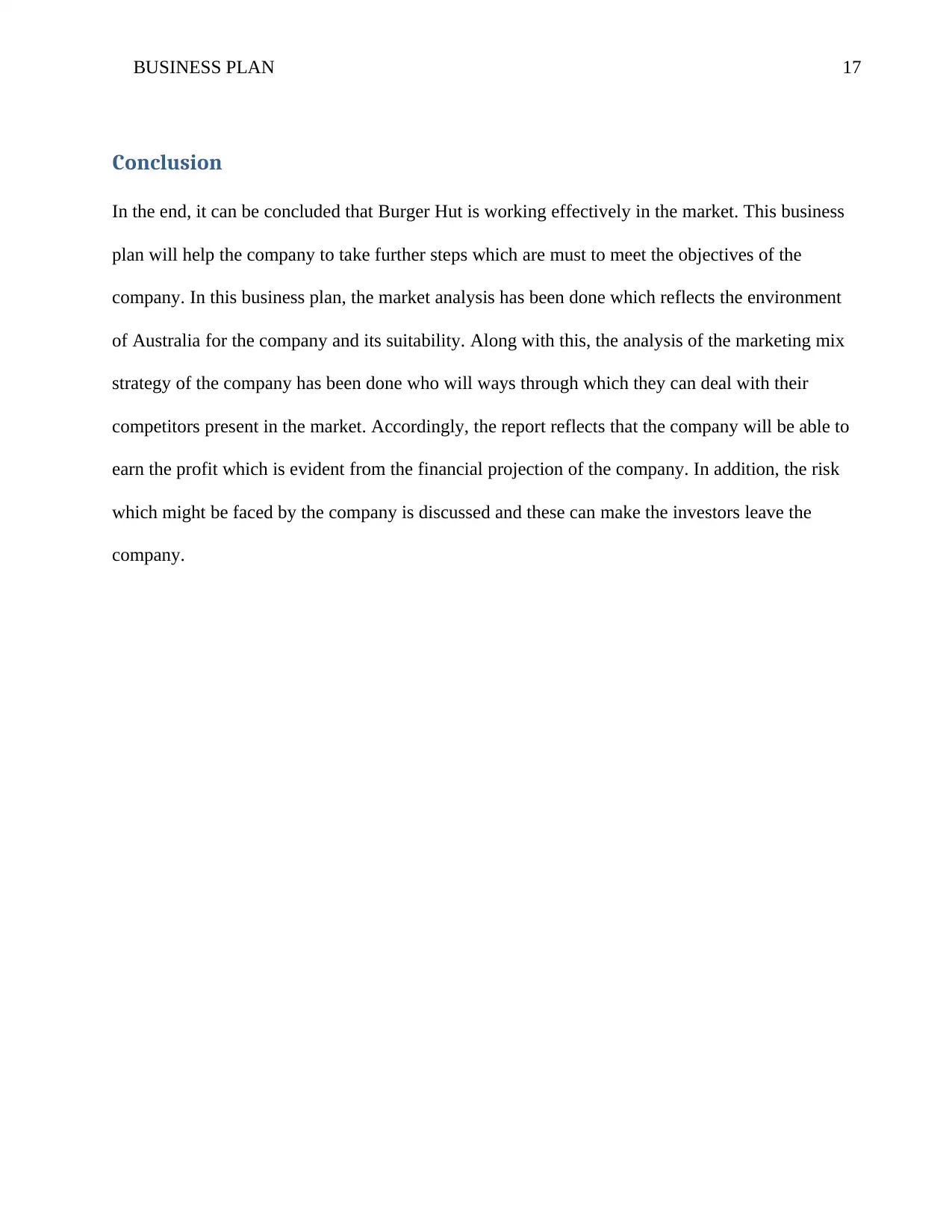
BUSINESS PLAN 17
Conclusion
In the end, it can be concluded that Burger Hut is working effectively in the market. This business
plan will help the company to take further steps which are must to meet the objectives of the
company. In this business plan, the market analysis has been done which reflects the environment
of Australia for the company and its suitability. Along with this, the analysis of the marketing mix
strategy of the company has been done who will ways through which they can deal with their
competitors present in the market. Accordingly, the report reflects that the company will be able to
earn the profit which is evident from the financial projection of the company. In addition, the risk
which might be faced by the company is discussed and these can make the investors leave the
company.
Conclusion
In the end, it can be concluded that Burger Hut is working effectively in the market. This business
plan will help the company to take further steps which are must to meet the objectives of the
company. In this business plan, the market analysis has been done which reflects the environment
of Australia for the company and its suitability. Along with this, the analysis of the marketing mix
strategy of the company has been done who will ways through which they can deal with their
competitors present in the market. Accordingly, the report reflects that the company will be able to
earn the profit which is evident from the financial projection of the company. In addition, the risk
which might be faced by the company is discussed and these can make the investors leave the
company.
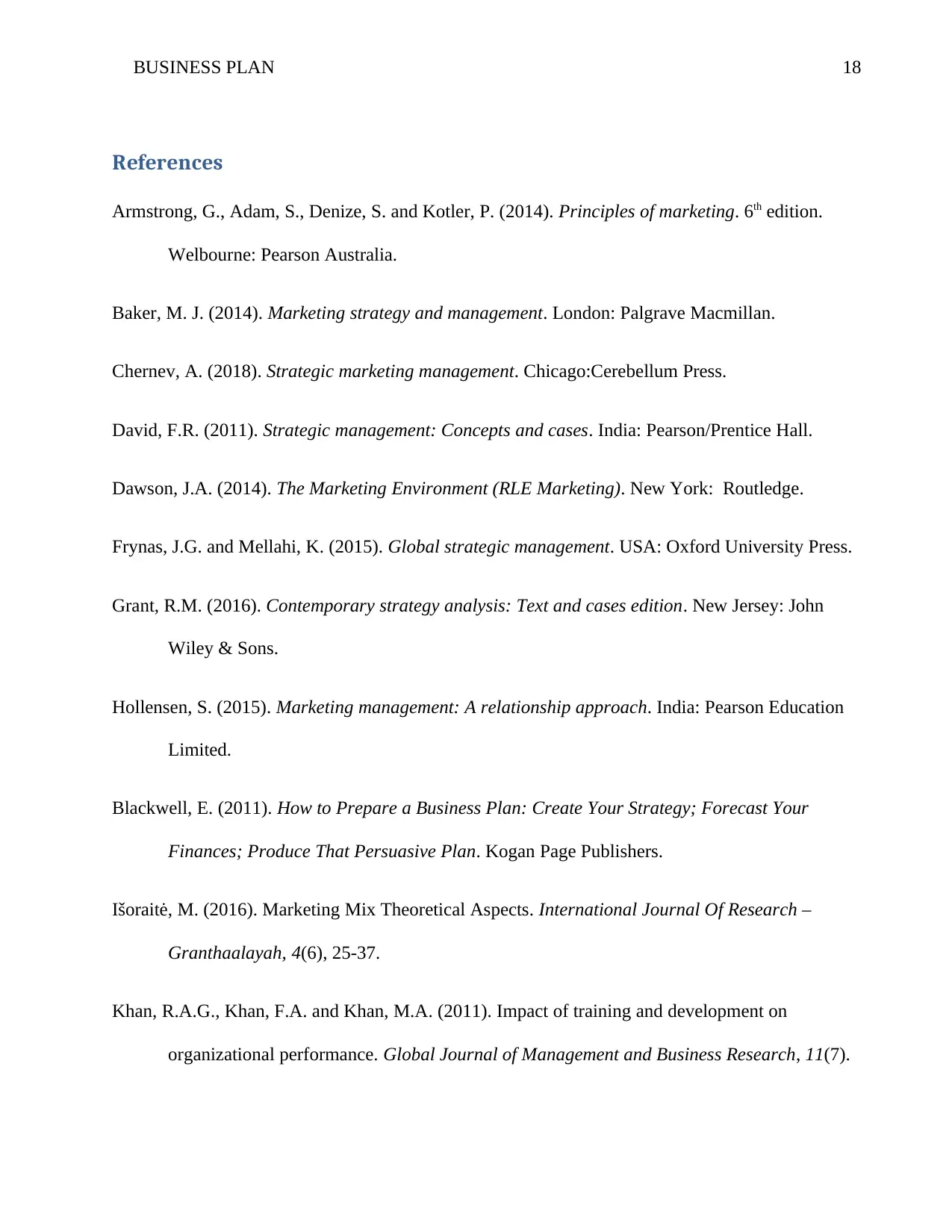
BUSINESS PLAN 18
References
Armstrong, G., Adam, S., Denize, S. and Kotler, P. (2014). Principles of marketing. 6th edition.
Welbourne: Pearson Australia.
Baker, M. J. (2014). Marketing strategy and management. London: Palgrave Macmillan.
Chernev, A. (2018). Strategic marketing management. Chicago:Cerebellum Press.
David, F.R. (2011). Strategic management: Concepts and cases. India: Pearson/Prentice Hall.
Dawson, J.A. (2014). The Marketing Environment (RLE Marketing). New York: Routledge.
Frynas, J.G. and Mellahi, K. (2015). Global strategic management. USA: Oxford University Press.
Grant, R.M. (2016). Contemporary strategy analysis: Text and cases edition. New Jersey: John
Wiley & Sons.
Hollensen, S. (2015). Marketing management: A relationship approach. India: Pearson Education
Limited.
Blackwell, E. (2011). How to Prepare a Business Plan: Create Your Strategy; Forecast Your
Finances; Produce That Persuasive Plan. Kogan Page Publishers.
Išoraitė, M. (2016). Marketing Mix Theoretical Aspects. International Journal Of Research –
Granthaalayah, 4(6), 25-37.
Khan, R.A.G., Khan, F.A. and Khan, M.A. (2011). Impact of training and development on
organizational performance. Global Journal of Management and Business Research, 11(7).
References
Armstrong, G., Adam, S., Denize, S. and Kotler, P. (2014). Principles of marketing. 6th edition.
Welbourne: Pearson Australia.
Baker, M. J. (2014). Marketing strategy and management. London: Palgrave Macmillan.
Chernev, A. (2018). Strategic marketing management. Chicago:Cerebellum Press.
David, F.R. (2011). Strategic management: Concepts and cases. India: Pearson/Prentice Hall.
Dawson, J.A. (2014). The Marketing Environment (RLE Marketing). New York: Routledge.
Frynas, J.G. and Mellahi, K. (2015). Global strategic management. USA: Oxford University Press.
Grant, R.M. (2016). Contemporary strategy analysis: Text and cases edition. New Jersey: John
Wiley & Sons.
Hollensen, S. (2015). Marketing management: A relationship approach. India: Pearson Education
Limited.
Blackwell, E. (2011). How to Prepare a Business Plan: Create Your Strategy; Forecast Your
Finances; Produce That Persuasive Plan. Kogan Page Publishers.
Išoraitė, M. (2016). Marketing Mix Theoretical Aspects. International Journal Of Research –
Granthaalayah, 4(6), 25-37.
Khan, R.A.G., Khan, F.A. and Khan, M.A. (2011). Impact of training and development on
organizational performance. Global Journal of Management and Business Research, 11(7).
Paraphrase This Document
Need a fresh take? Get an instant paraphrase of this document with our AI Paraphraser
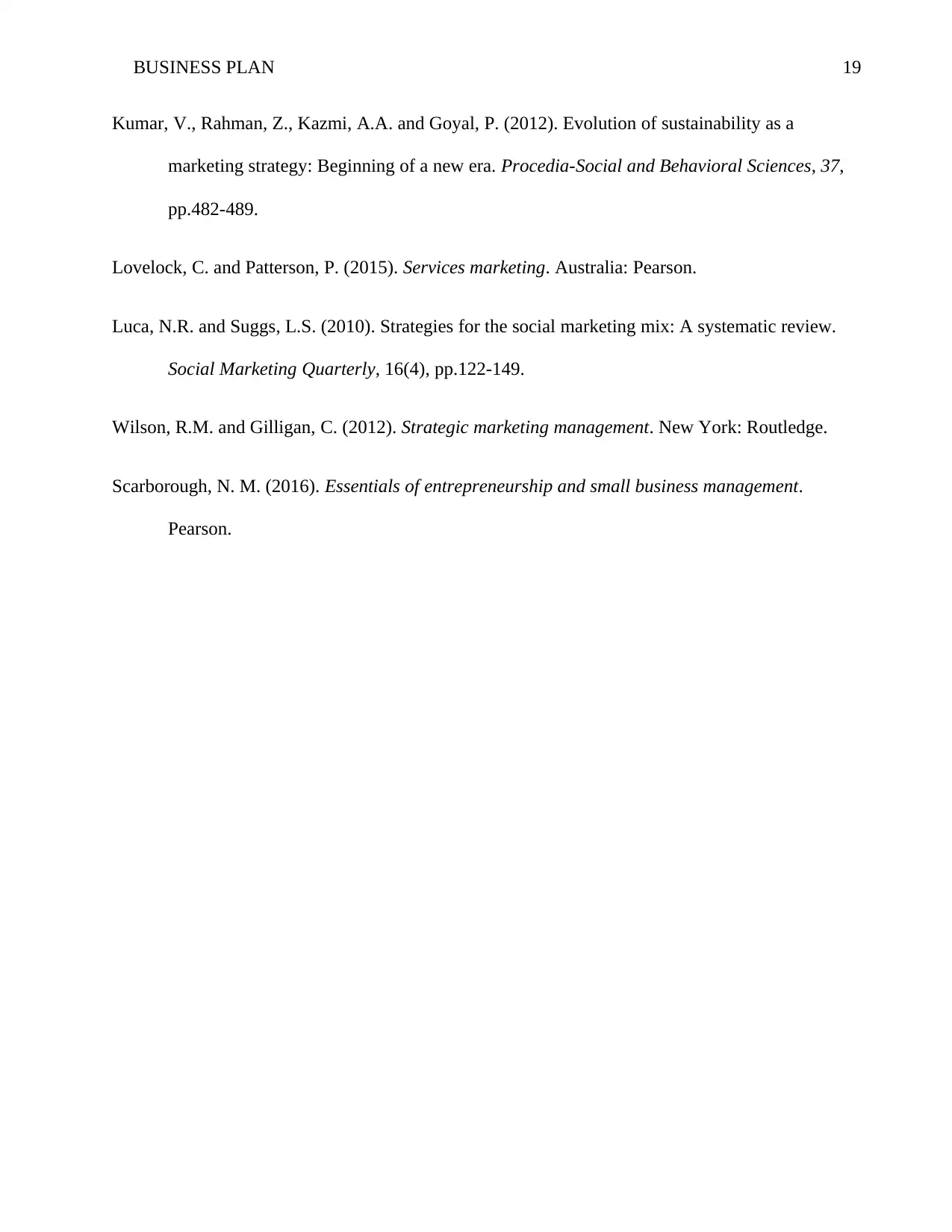
BUSINESS PLAN 19
Kumar, V., Rahman, Z., Kazmi, A.A. and Goyal, P. (2012). Evolution of sustainability as a
marketing strategy: Beginning of a new era. Procedia-Social and Behavioral Sciences, 37,
pp.482-489.
Lovelock, C. and Patterson, P. (2015). Services marketing. Australia: Pearson.
Luca, N.R. and Suggs, L.S. (2010). Strategies for the social marketing mix: A systematic review.
Social Marketing Quarterly, 16(4), pp.122-149.
Wilson, R.M. and Gilligan, C. (2012). Strategic marketing management. New York: Routledge.
Scarborough, N. M. (2016). Essentials of entrepreneurship and small business management.
Pearson.
Kumar, V., Rahman, Z., Kazmi, A.A. and Goyal, P. (2012). Evolution of sustainability as a
marketing strategy: Beginning of a new era. Procedia-Social and Behavioral Sciences, 37,
pp.482-489.
Lovelock, C. and Patterson, P. (2015). Services marketing. Australia: Pearson.
Luca, N.R. and Suggs, L.S. (2010). Strategies for the social marketing mix: A systematic review.
Social Marketing Quarterly, 16(4), pp.122-149.
Wilson, R.M. and Gilligan, C. (2012). Strategic marketing management. New York: Routledge.
Scarborough, N. M. (2016). Essentials of entrepreneurship and small business management.
Pearson.
1 out of 20
Related Documents
Your All-in-One AI-Powered Toolkit for Academic Success.
+13062052269
info@desklib.com
Available 24*7 on WhatsApp / Email
![[object Object]](/_next/static/media/star-bottom.7253800d.svg)
Unlock your academic potential
© 2024 | Zucol Services PVT LTD | All rights reserved.





